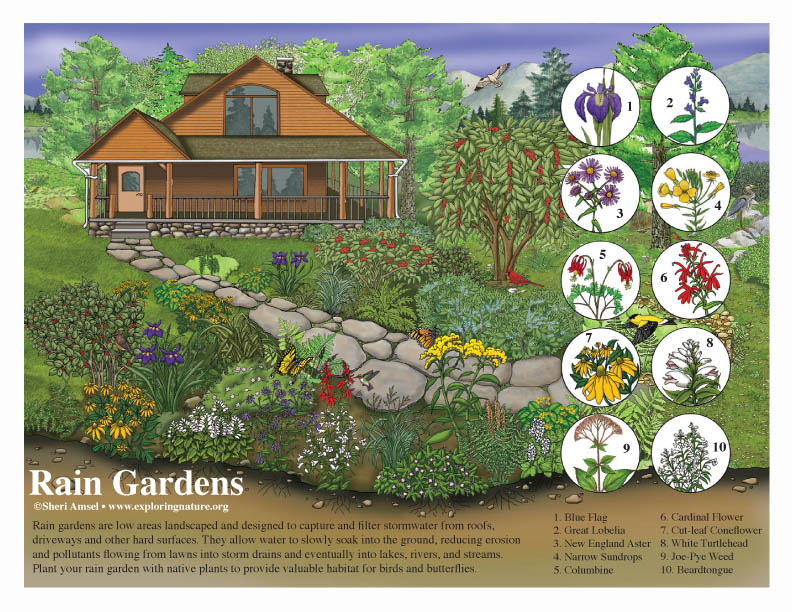

Rain Garden Facts
1. Rain gardens help collect rainwater that flows off roofs and paved areas in cities and suburbs, so it doesn’t flood the streets. Paved surfaces don’t absorb water so build up runoff until the flow is large enough to cause erosion and damage. So they reduce erosion after storms.
2. Rain gardens help stop rainstorm runoff from carrying pollutants into streams and lakes. Stormwater is polluted by picking up debris, chemicals, dirt and litter off of paved surfaces and carrying them along with it. They can even pick up bacteria from septic systems and carry it toward where we get drinking water or swim.
3. Rain gardens allow more water to drain back into the ground, filtering out pollutants and refilling important underground aquifers.
5. When planted with native plants, rain gardens can provide important habitat for birds, butterflies and other insects - and they’re pretty!
How to Build a Rain Garden
1. First pick a dry, sunny spot in the yard. It shouldn’t be too close to the house (or building). It should be kind of flat. Test the ground by digging a hole. Then fill it with water and leave it over night. If the hole is still full of water the next day, this is not a good spot for the rain garden. Rain gardens need sandy soil that will drain water away in a few hours.
2. Mark the edges of where the rain garden will be. Start with a spot that is about ten feet wide. Kidney bean-shape is a nice shape for a rain garden. Use a shovel to dig out the grass. Pile the clumps of grass neatly around the edges of the rain garden in a u-shape, like the walls of a fort. This is called a berm. The berm will hold the water in the garden after the rainstorm until it has time to drain away into the ground. Leave the side facing the house open so it will that catch water that flows from the house, driveway and sidewalks.
3. Dig down a few inches and loosen up the dirt. This will make it easier for the roots of the plants to grow.
4. Go to the local nursery to look for bushes, trees and plants that live in your area. These are called native plants. Native plants are used to our weather - wet or dry. Pick out plants that will bloom at different times in the summer. Plant some plants on the berm and some plants in the rain garden itself. This is where the water will pool after each storm. These plants need to able to sit in water from time to time. Plants can be chosen to attract butterflies and birds.
5. For the first season pull up weeds and give it the garden water. By the next summer the rain garden will be on its own. The flowers will bloom. Butterflies and bees will come to pollinate them. Birds will come to find nest materials. When it rains, the rain garden will fill up with water and be a little pond. Then, after a few hours, the water will drain away and it will be a garden again.
When you research information you must cite the reference. Citing for websites is different from citing from books, magazines and periodicals. The style of citing shown here is from the MLA Style Citations (Modern Language Association).
When citing a WEBSITE the general format is as follows.
Author Last Name, First Name(s). "Title: Subtitle of Part of Web Page, if appropriate." Title: Subtitle: Section of Page if appropriate. Sponsoring/Publishing Agency, If Given. Additional significant descriptive information. Date of Electronic Publication or other Date, such as Last Updated. Day Month Year of access < URL >.
Amsel, Sheri. "Build a Rain Garden" Exploring Nature Educational Resource ©2005-2024. March 27, 2024
< http://www.exploringnature.org/db/view/1178 >


